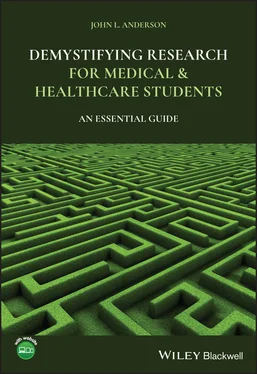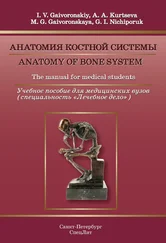All these approaches are shown in this figure and you can use this as a ‘mind map’ to negotiate the different topics covered in this book.

These are approaches in which we measure and count things. We use statistical methods to analyse the numerical date which we collect. These approaches fall into two categories – experimental,or interventional approaches, and observational,or non‐experimental and non‐interventional, approaches.
WARNING – Note the use of the term ‘observational’. It does not refer to observation in the sense of observing something, but means that there is no experimentation or intervention. We do not manipulate any variables or make any experimental interventions.
So, in experimentalapproaches, we introduce some change and then measure any effects which are thought to be ‘caused’ by that change. In observationalapproaches, there is no change – we measure things as they are. Let's look at the three main categories of these first.
Observational or Non‐experimental Approaches
1 Cross‐sectional studies: These are the commonest type of studies used in quantitative research. They involve taking a ‘snapshot’ of what is happening in a group or a population at a particular point in time. The most widely used approach is the survey. These are termed ‘retrospective’ studies, because what we are enquiring about has already happened – it is in the past. We shall look at these in depth later in Chapters 8and 9.
2 Case‐control studies: Case‐control studies are commonly used in epidemiological research when we want to check what factors cause a disease that we are concerned about. These are a pleasingly neat design. We identify and recruit a group of people with a disease, then we identify and recruit a group of people who are similar in almost every respect – except that they do not have that disease. Then we measure the extent to which each group have been exposed to a suspected causal factor and measure the difference between the two groups. If the ‘Cases’ score higher than the ‘Controls’, then we conclude that the factor we are comparing them on is indeed a suspected contributory factor for that disease or condition. Neat – eh? These are also termed ‘retrospective’ studies because what we are enquiring about has already happened – it is in the past. We shall look at these in depth later in Chapter 7.
3 Cohort studies: The term cohort is a posh word for a group. It comes from the Latin ‘cohors’ which was a group of soldiers in a Roman Legion – a platoon, sort of. In cohort studies, we recruit a group of people and follow them up over a period of time. We may choose people for a specific reason or a wide range of reasons and record significant events as they arise. These are different to the last two approaches in that they are not ‘retrospective’ studies, because we are interested in what will happen – in the future. They are what we call ‘prospective’ studies. We shall look at these in depth in Chapter 6.
1 Laboratory experiments: Most of us will remember our time in laboratories doing experiments. I remember tedious hours of work in the Chemistry labs doing titrations. You know, the sort of experiment where you have a measured amount of one chemical, A, in a beaker, and you painstakingly introduce into this – drip by boring drip – another chemical, B, from a burette … The rationale of these experimental studies is simple – you have almost complete control over the experimental environment, so that you can rule out extraneous (external) variables, such as spores that drift in the open window (as happened to Alexander Fleming – a sloppy researcher!) and you can reasonably confidently assume that any changes you record are due to the experimental variable that you have introduced. We can also use a control situation – for example, in culture studies, we would leave a petri dish with no culture for testing alongside the test dishes. Then we can identify the ‘Fleming effect’ if some external ‘contaminant’ gets in by chance and corrupts our findings.Laboratory experiments can also be conducted with animal and human ‘subjects’ or ‘participants’ and I shall go into depth on these in the Chapters 2and 3.
2 Non‐randomised trials: These are experimental approaches (often used in drug development) in which an experiment is conducted – but there is no control situation or control group. These are covered in depth in Chapter 4.
3 Randomised control trials ( RCTs ): These are perhaps the most widely known and widely used experimental approach in medicine. Here we take the rationale of the laboratory experiment and take it beyond the laboratory. These are widely used to test the efficacy of new interventions or diagnostic tools. We recruit a group of participants and randomly allocate them to an experimental group or a control group. Those in the experimental group are given a new drug or treatment, whilst those in the control group get their standard treatment, usually with a placebo – an inert drug or treatment. If those in the experimental group do better than those in the control group, then we conclude that the new drug or treatment is better than the standard – or no treatment. There are many issues involved in RCTs and I shall discuss these in depth in Chapter 5.
These are approaches which do not involve numbers. Often the topic does not lend itself to quantifying – for example, when we are interested in studying people’s belief‐systems, or feelings. Sometimes the conventional approaches to sampling are not possible or do not make sense and therefore we chose a different approach from the ones described above. There are very many qualitative approaches, but for simplicity, I shall focus on the three most commonly used approaches.
1 Grounded Theory: Grounded Theory was developed by Barley Glaser and Anselm Strauss. Their book The Discovery of Grounded Theory was written at a time (1968) when there were very few academic books on qualitative research, other than ethnographic ones. Their aims in writing this book were to provide research students with a textbook to cite in defence of their qualitative approach, and to challenge the orthodox dominance of quantitative researchers in social sciences. They had conducted studies of death and dying in US hospitals – which is where I came into contact with them (I was working on the Life Before Death study and we wrote to ask them for any advice they could give – see Chapter 8). They describe an approach in which theory arises from and develops from the data as it is collected – for example, from observations, interviews, etc. I shall go into depth in these in the Chapter 14.
2 Ethnographic approaches: Ethnographic approaches have their roots in Anthropology. In particular, the work of early anthropologists to document and analyse societies and cultures in the developing world. The most common practice in this sort of research was for the researcher to go to a particular society and study it – as a participant observer. This meant living with and being part of the system that they are studying. By immersing themselves into and observing the life of that group of people and the events which happened to them – including the sense, or meaning that they attributed to them – they were able to try to make sense of that social system, So, what's this got to do with modern healthcare? Well, this approach has been adapted to researchers getting involved with particular social groups or situations – such as being admitted to hospital, working in care homes, etc., in order to get an ‘insider’ view of the experience and what is going on (see Chapter 11).More common, now, is to try to make sense of the cultural aspects of a group or situation by interviewing people – either individually or in focus groups – to capture their beliefs and practices. I shall go into depth and provide some rich examples of these in the Chapter 12.
Читать дальше













